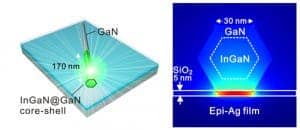Scientists at the University of Texas at Austin, in collaboration with colleagues in Taiwan and China, have developed what’s considered to be the world’s smallest laser; a device so tiny, that it’s invisible to the naked eye. The laser is heralded as a breakthrough in the emerging photonic technology with applications from computing to medicine.
Specialists in photon-based technologies, like ultrafast computer chips, highly sensitive biosensors for detecting, treating and studying disease or the next-generation communication devices, will tell you at any time that the key to pushing the envelope forward in the field is based on two very important parameters: energy and size, and both need to be smaller. You can only get so low until you hit a brick wall, though, or what’s known for physicists as the three-dimensional optical diffraction limit.

“We have developed a nanolaser device that operates well below the 3-D diffraction limit,” said Chih-Kang “Ken” Shih, professor of physics at The University of Texas at Austin. “We believe our research could have a large impact on nanoscale technologies.”
In their paper recently published in the journal Science, Shih and colleagues report on the first operation of a continuous-wave, low-threshold laser below the 3-D diffraction limit. When fired, the nanolaser emits a green light. The device is made of a gallium nitride nano-rod , partially filled with indium gallium nitride – both are semiconductor alloys used commonly in LEDs.
The nanorod is the key to the physicists’ success, a material that the Shih lab has been perfecting for more than 15 years. The nanorod is placed on top of a thin insulating layer of silicon that in turn covers a layer of silver film that is smooth at the atomic level. “Atomically smooth plasmonic structures are highly desirable building blocks for applications with low loss of data,” said Shih.
“Size mismatches between electronics and photonics have been a huge barrier to realize on-chip optical communications and computing systems,” said Shangjr Gwo, professor at National Tsing Hua University in Taiwan and a former doctoral student of Shih’s.
The researchers hope this impediment will finally be jumped once “on-chip” communication systems (chips where all processes are contained on the chip) are developed, with the help of the knowledge gained from developing the world’s tiniest laser.
source






